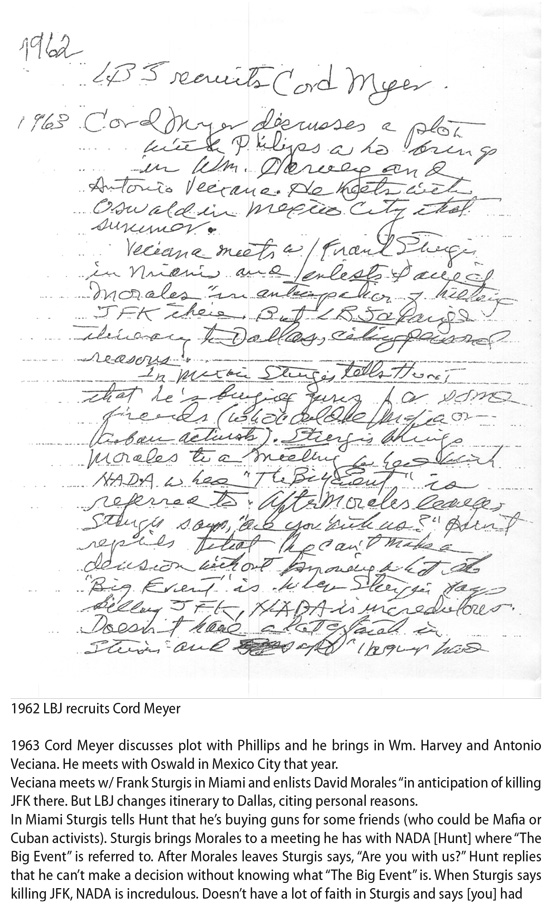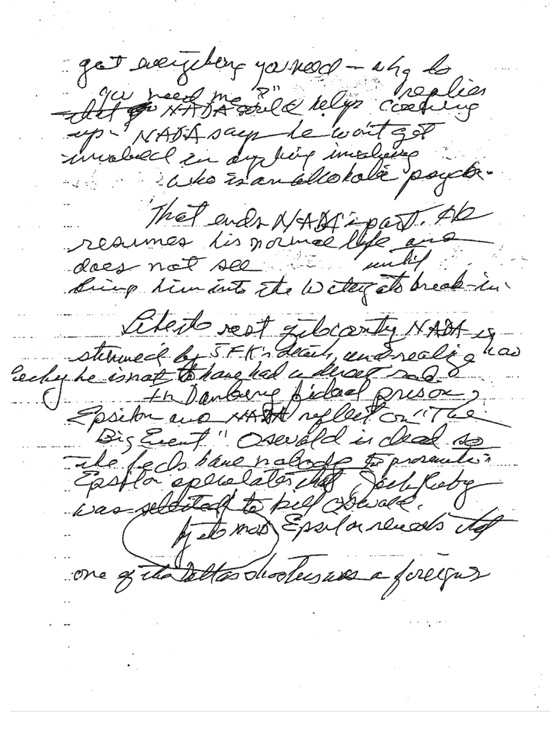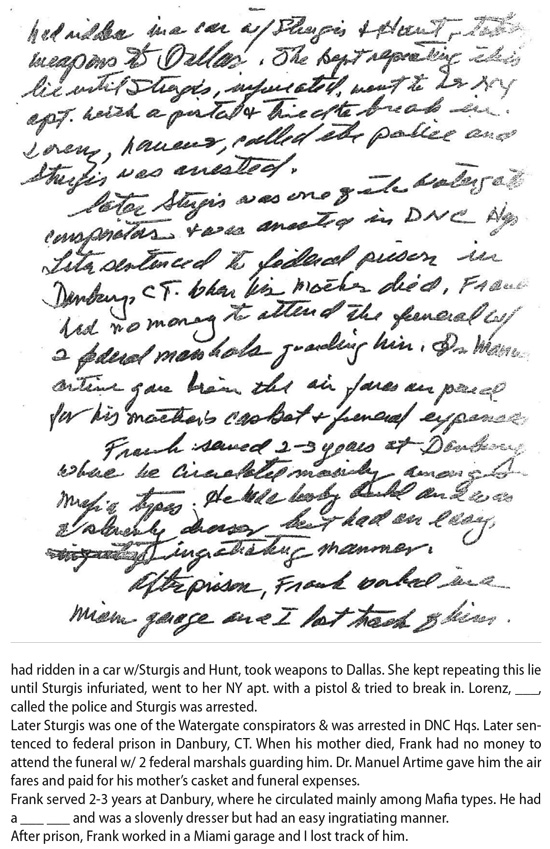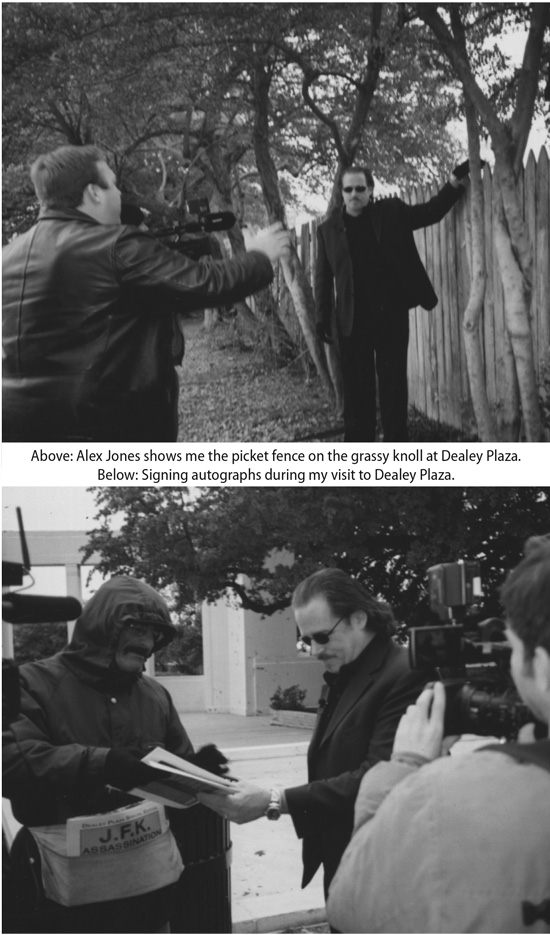
Recorded January 2004
I heard from Frank that LBJ had designated Cord Meyer Jr. to undertake a larger organization while keeping it totally secret.
Cord Meyer himself was a rather favorite member of the Eastern aristocracy. He was a graduate of Yale University and had joined the Marine Corps during the war and lost an eye in the Pacific fighting.
I think that LBJ settled on Meyer as an opportunist (unintelligible) like himself (unintelligible) in a man who had very little left to him in life ever since JFK had taken Cords wife as one of his mistresses.
I would suggest that Cord Meyer welcomed the approach from LBJ who was after all only the Vice President at that time and of course could not number Cord Meyer among JFK’s admirers; quite the contrary.
As for Dave Phillips, I knew him pretty well at one time. He worked for me during the Guatemala project. He made himself useful to the agency in Santiago, Chile where he was an American businessman. In any case, his actions, whatever they were, came to the attention of the Santiago Station Chief and when his resume became known to people in the Western Hemisphere Division he was brought in to work on Guatemalan operations.
Sturgis and Morales and people of that ilk, stayed in apartment houses during preparations for the big event. Their addresses were very subject to change so that where a fellow like Morales had been one day, you’d not necessarily associated with that address the following day. In short it was a very mobile experience.
Let me point out at this point, that if I wanted to fictionalize what went on in Miami and elsewhere during the run up for the big event, I would have done so.
But I don’t want any unreality to tinge this particular story – or the information I should say. I was a benchwarmer on it and I had a reputation for honesty.
I think it’s essential to refocus on what this information, that I’ve been providing you – and you alone by the way, consists of. What is important in the story is that we backtrack the chain of command up through Cord Meyer and laying the doings at the doorstep of LBJ.
He in my opinion, had an almost maniacal urge to become President. He regarded JFK, as – as he was in fact, an obstacle to achieving that. He could have waited for JFK to finish out his term and then undoubtedly a second term.
So that would have put LBJ at the head of a long list of people who were waiting for some change in the Executive Branch.

















Even though he confessed he was a ”benchwarmer” and named names of folks he said were involved in the JFK assassination, up to his death my father denied this testimony by Marita Lorenz. This deposition was entered into the court record during the course of the retrial of the Spotlight libel suit. The full transcript of the deposition does offer quandaries concerning it’s validity, and Lorenz’s testimony has been questioned by some JFK assassination researchers.
An excerpt from Plausible Denial, pp. 291-302.
To present Marita Lorenz’s testimony. I arranged for Julia Lee, the wife of Liberty Lobby general counsel Fleming Lee, to study the deposition transcript. At the trial she took the witness chair and answered questions by reading from the transcript. The jury was informed, of course, that the witness was not Lorenz but the testimony was authentic.
The testimony began:
Q: What is your present employment?
A: I do undercover work for an intelligence agency.
Q: Are you permitted to discuss the nature of that work, or where you work?
A: No, I am not.
Q: Is it also true that, as I have stipulated, you do not wish to give your home address?
A: No. I do not.
Q: Have you been employed by the Central Intelligence Agency?
A: Yes.
Q: Are you at liberty to discuss the details of that employment?
A: No.
Q: Have you been employed by the Federal Bureau of Investigation?
A: Yes.
Q: Are you at liberty to discuss that?
A: No.
Q: Have you been employed by the New York Police Department?
A: Yes.
Q: Was that intelligence work?
A: Yes.
Q: Are you at liberty to discuss the details of that work?
A: No.
Q: During 1978, did you appear as a witness before the United States House of Representatives Select Committee on Assassinations?
A: Yes.
Q: Did you appear as a witness after the chief judge of the United States District court of Washington had signed an offer conferring immunity upon you and compelling you to testify?
A: Yes.
My questions and her answers established the foundation for the relationship that existed among Lorenz, Hunt, and Sturgis. I then moved toward the matter at hand.
Q: During and prior to November 1963, did you live in Miami, Florida?
A: Yes, I did.
Q: I want you to understand, if I ask you any question which you are not permitted to answer, you may of course say that, but I will try, based on my previous interview with you, to just ask you questions which you can answer.
A: Yes.
Q: During and before November of 1963, did you work on behalf of the Central Intelligence Agency in the Miami area?
A: Yes.
Q: Did you work with a man named Frank Sturgis, while you were working for the CIA?
A: Yes, I did.
Q: Was that in Miami, during and prior to November 1963?
A: Yes.
Q: What other names, to your knowledge, is Frank Sturgis known by?
A: Frank Fiorini, Hamilton; the last name, Hamilton. F-I-O-R-I-N-I-.
Q: Was Mr. Fiorini or Mr. Sturgis, while you worked with him, also employed by the Central Intelligence Agency?
A: Yes.
Q: During that time were payments made to Mr. Sturgis for the work he was doing for the CIA?
A: Yes.
Q: Did you ever witness anyone make payments to him for the CIA work which you and Mr. Sturgis were both involved in?
A: Yes.
[misc. tidbits deleted...]
It was clear that Lorenz was about to reveal the name of the paymaster and control for Sturgis’s secret operations. The courtroom was hushed. Even the miscellaneous spectator background sounds, coughing, clearing of throats, rustling of papers, and moving about came to a sudden, almost eerie, halt.
Q: Who did you witness make payments to Mr. Sturgis?
A: A man by the name of Eduardo.
Q: Who is Eduardo?
A: That is his code name; the real name is E. Howard Hunt.
[At this point Hunt began to confer with his attorneys]
Q: Did you know him and meet him during and prior to November 1963?
A: Yes.
We then moved to the events immediately preceding the assassination of President Kennedy.
Q: Did you go on a trip with Mr. Sturgis from Miami during November of 1963?
A: Yes.
Q: Was anyone else present with you when you went on that trip?
A: Yes.
Q: What method of transportation did you use?
A: By car.
Q: Was there one or more cars?
A: There was a follow-up car.
Q: Does that mean two cars?
A: Backup; yes.
Q: What was in the follow-up car, if you know?
A: Weapons.
Q: Without asking you any of the details regarding the activity that you and Mr. Sturgis and Mr. Hunt were involved in, may I ask you if some of that activity was related to the transportation of weapons?
A: Yes.
Q: Did Mr. Hunt pay Mr. Sturgis sums of money for activity related to the transportation of weapons?
A: Yes.
Q: Did Mr. Sturgis tell you where you would be going from Miami, Florida, during November of 1963, prior to the time that you traveled with him in the car?
A: Dallas, Texas.
Q: He told you that?
A: Yes.
Q: Did he tell you the purpose of the trip to Dallas, Texas?
A: No; he said it was confidential.
Q: Did you arrive in Dallas during November of 1963?
A: Yes.
Q: After you arrived in Dallas, did you stay at any accommodations there?
A: Motel.
Q: While you were at that motel, did you meet anyone other than those who were in the party traveling with you from Miami to Dallas?
A: Yes.
Q: Who did you meet?
A: E. Howard Hunt.
Marita Lorenz then provided details about her stay in Dallas.
Q: Was there anyone else who you saw or met other than Mr. Hunt?
A: Excuse me?
Q: Other than those?
A: Jack Ruby.
Q: Tell me the circumstances regarding your seeing E. Howard Hunt in Dallas in November of 1963?
A: There was a prearranged meeting that E. Howard Hunt deliver us sums of money for the so-called operation that I did not know its nature.
Q: Were you told what your role was to be?
A: Just a decoy at the time.
Q: Did you see Mr. Hunt actually deliver money to anyone in the motel room which you were present in?
A: Yes.
Q: To who did you see him deliver the money?
A: He gave an envelope of cash to Frank Fiorini.
Q: When he gave him the envelope, was the cash visible as he had it in the envelope?
A: Yes.
Q: Did you have a chance to see the cash after the envelope was given to Mr. Fiorini?
A: Frank pulled out the money and flipped it and counted it and said “that is enough” and put it in his jacket.
Q: How long did Mr. Hunt remain in the room?
A: About forty-five minutes.
Q: Did anyone else enter the room other than you, Mr. Fiorini, Mr. Hunt, and others who may have been there before Mr. Hunt arrived?
A: No.
Q: Where did you see the person you identified as Jack Ruby?
A: After Eduardo left, a fellow came to the door and it was Jack Ruby, about an hour later, forty-five minutes to an hour later.
Q: When you say Eduardo, who are you referring to?
A: E. Howard Hunt.
The presence of Ruby, the man who had been a hit man for organized crime as early as 1939 in Chicago, and who served as an FBI informant in Dallas since 1959, brought the circle closer.
Q: When did that meeting take place in terms of the hour; was it daytime or nighttime?
A: Early evening.
Q: How soon after that evening meeting took place did you leave Dallas?
A: I left about two hours later; Frank took me to the airport and we went back to Miami.
Q: Now, can you tell us in relationship to the day that President Kennedy was killed, when this meeting took place?
A: The day before.
Q: Is it your testimony that the meeting which you just described with Mr. Hunt making the payment of money to Mr. Sturgis took place on November 21, 1963?
A: Yes.
Q: When was the first time that you met me?
A: In 1977.
Q: On that occasion, did you tell me in words or substance exactly the same thing that you have testified to today?
A: Yes.
The original focus at the first trial by Hunt’s lawyer, Ellis Rubin, upon the importance of establishing Hunt’s alleged absence from Dallas on November 22, had so skewed the defense that the CIA sought out witnesses and documentary evidence to provide a false alibi for the wrong day.
...Thus Hunt’s CIA witnesses, misled as to the implications of the record, focused upon November 22 to the exclusion of the previous day.
...Hunt himself was misled as to his own objective. When I confronted Hunt with the fact that CIA records disclosed that he had taken eleven hours of sick leave in the two-week period ending November 23, 1963, he responded that he was quite sure he had not utilized any of those eleven hours on November 22.
Having decided that he had exculpated himself from the relevant potential accusation, he agreed that it was certainly possible that he had been absent from work on November 21.
...During the Lorenz deposition I inquired about her identification of the man she described as Jack Ruby.
Q: Two days after President Kennedy was assassinated, that is on November 24, 1963, Lee Harvey Oswald, who was arrested and charged with the assassination of President Kennedy and the murder of police officer J.D. Tippit, was killed in Dallas by a man named Jack Ruby?
A: Yes.
Q: On that occasion and subsequent to that time, did you see pictures of Jack Ruby in the newspaper and did you see Jack Ruby on television.
A: Yes, I did.
Q: Is it your testimony that the man who killed Lee Harvey Oswald is, to the best of your ability to identify him, the person who was in the room in the motel in Dallas the night before the president was killed?
A: Yes.
Q: Had you ever seen Jack Ruby before November 21, 1963?
A: No.
Dunne’s cross-examination did not succeed in calling into question a single statement that she had made. Indeed, it provided an opportunity for her to fill in a number of details.
...When asked why she had not appeared before the Warren Commission, she testified that she was instructed by her superiors in the CIA not to do so. Dunne persisted.
Q: Is it your testimony today, that today’s testimony is consistent with what you said before the House Select Committee?
A: That’s right.
Q: When was the first time you met Howard Hunt?
A: 1960, in Miami, Florida.
Q: How was he identified to you?
A: Introduced. Introduced as Eduardo.
Q: How do you spell that?
A: E-D-U-A-R-D-O., Eduardo. E-D-U-A-R-D-O. He was to finance the operations in Miami.
Q: What language did he speak to you in?
A: English and Spanish.
Q: English and Spanish?
A: Yes.
Q: Do you speak Spanish?
A: Yes.
Q: Any other languages?
A: German.
Q: When is it that you became aware that this person you know as Eduardo was E. Howard Hunt?
A: About the same time. Eduardo was the name we were to refer to him as, when discussing things.
Q: Who did you believe he was working for at that time?
A: CIA.
Q: Why?
A: Because we were all at that time CIA members of Operation 40. We had been given instructions from Eduardo and had certain rights and permissions to do things that the average citizen could not do.
When Dunne asked her about her early experiences for the CIA in Cuba she answered:
“I will tell you what is on record. I stole secrets from Cuba. I was trained to kill. Anything else?”
During my interview with Marita prior to the deposition, I had asked for the names of the other persons in the two-car caravan from Miami to Dallas. She was very reluctant to answer that question: “They killed Kennedy. I don’t want to be the one to give their names; it’s too dangerous.” I told her that I would neither pursue the matter then nor inquire of her about their identities at the deposition. I told her that it was possible, however, that Hunt’s lawyer might ask that question.
At the deposition, Hunt’s lawyer demanded that she provide the name of one more person in the automobile with her. She looked at me, stared at Dunne as if to say, “Well, you asked for this,” and responded:
A: The other one was Jerry Patrick ....
Q: Jerry Patrick ... ?
A: Hemming.
Q: Is that, H-E-M-M-I-N-G?
A: Yes.
She added that two Cuban brothers named Novis and a pilot named Pedro Diaz Lanz were also in the caravan.
After the deposition I discussed that question with her. She said, ,“If Hunt and his friends in the CIA wanted that question answered, or were too dumb or lazy to keep their lawyer from asking it, the responsibility is theirs, not mine.”
Dunne wanted to know about the weapons.
Q: Did you see the weapons in the second car?
A: Yes.
Q: What kinds of weapons were there?
A: Handguns and automatics.
Q: Could you identify for me today what kind of guns they were, specifically?
A: Rifles; there were cases of machine guns, rifles, thirty-eights, forty-fives.
Q: Have you been trained in firearms?
A: Yes.
Q: What were the kind of rifles that were there?
A: M-16’s, M-1s, shotguns; several.
Q: There were machine guns?
A: Yes.
Q: In your work for the CIA Operation 40, was that one of the major tasks you undertook was to transport guns?
A: Yes.
Q: Was that for the anti-Cuba activities.
A: Yes, it was.
Q: What happened to those guns when you got to Dallas.
A: They were in the car and I presume they took them to the motel the next day, the next night. A lot of things they carried in.
Q: Were did you leave from?
A: From the house in Miami.
Q: Is that a CIA house?
A: A safe house. Yes.
Q: Did everyone meet at the same place?
A: Yes.
Q: Who else was at the house, besides the seven people you identified?
A: This fellow is incarcerated; it is not fair to answer. Another fellow is dead:
Q: Incarcerated where?
A: Out of the country, right now, Venezuela somewhere.
Q: Is his name Bosch?
A: Yes.
Q: What is his first name?
A: Orlando.
Q: Was he one of the anti-Castro Cubans involved in Operation 40?
A: Yes.
Q: Isn’t that a matter of public record?
A: Yes.
I broke in to address Dunne: “It’s not a matter of public record that he was at the house that day....”
Q: Who was the person at the house that is now deceased?
A: Alexander Rorke, Jr.
Q: Is he a CIA employee?
A: Yes.
Q: What did you do after you got to New York and found out that President Kennedy was just assassinated in Dallas?
A: Talked to the FBI.
Q: You talked to the FBI?
A: Yes.
Q: Voluntarily?
A: They wanted to talk to me about certain things with my child’s father and they picked me up and took me to the office.
Q: What day would that have been?
A: A few days after I arrived, after everyone got over the initial shock.
Q: It would be some time in the month of November of 1963?
A: Yes.
Q: In your discussions with the FBI, they inquired about your activities which related to Dallas and this group of seven people that took the car trip?
A: Well, they discussed my associates down there and my relationship with my daughter’s father, mostly.
Q: Did they know the names of the people you took the car trip with, from Miami to Dallas?
A: Yes.
Q: Did they ask you about each of those people?
A: Yes.
Q: Did you tell them about the guns and money and about Eduardo?
A: Yes. They asked me about everything, my daughter’s father, and I am glad I am back up here away from that.
Q: You told them about Eduardo?
A: Yes.
Q: And the guns?
A: They know about all those associations. They didn’t want to go into it. Those were CIA activities, not FBI.
Before the day ended Marita Lorenz explained why she had left Dallas before the assassination:
“I knew that this was different from other jobs. This was not just gun-running. This was big, very big, and I wanted to get out. I told Sturgis I wanted to leave. He said it was a very big operation but that my part was not so dangerous. I was to be a decoy. Before he could go further, I said please let me get out. I want to go back to my baby in Miami.
[...counsel for the prosecution continues - narrating]
Dunne had developed a penchant for not leaving bad enough alone. The testimony of the witness had implicated Hunt and Sturgis in the assassination. Dunne decided to put a fine point to the testimony.
Q: Did you ever talk with Frank Sturgis about it since then?
Lorenz was reluctant to respond directly to the question.
A: We are not on talking terms, Frank and I.
Q: That was not my question. Have you ever talked about it with Frank Sturgis since 1963?
A: Yes.
Q: Did he ever indicate to you that he was involved in the assassination of the President?
A: Yes
Dunne continued to ask questions that Marita Lorenz had requested that I avoid. Due to my commitment to her, I did not make the inquiries, but Dunne rushed in asking questions to which he did not know the answer.
Later Lorenz, prompted by Dunne’s questions, explained that when Sturgis sought to recruit her for yet another CIA project, he told her that she had “missed the really big one” in Dallas. He explained, she said, “We killed the President that day. You could have been a part of it – you know, part of history. You should have stayed. It was safe. Everything was covered in advance. No arrests, no real newspaper investigation. It was all covered. Very professional.”
Used by permission.
Plausible Denial: Was the CIA Involved in the Assassination of JFK?
Thunder’s Mouth Press
© 1991 Mark Lane